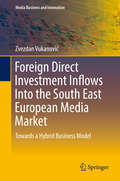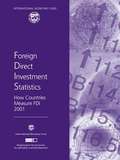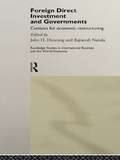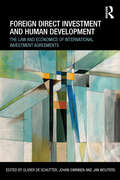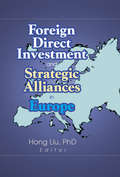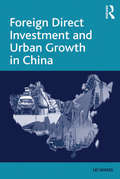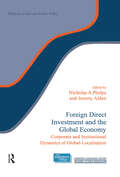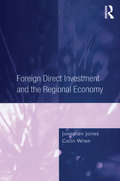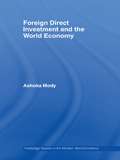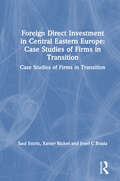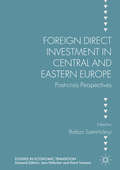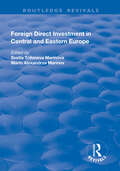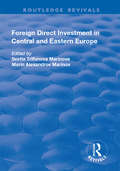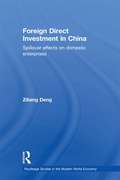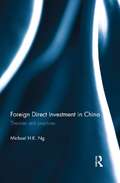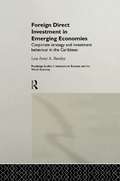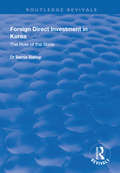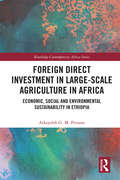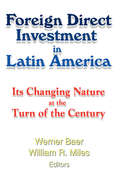- Table View
- List View
Foreign Direct Investment
by Laura Alfaro Esteban ClavellBriefly reviews motivations and trends behind foreign direct investment and multinational corporations as well as the policy debate that surrounds them.
Foreign Direct Investment Inflows Into the South East European Media Market
by Zvezdan VukanovićThis book offers a strategic analysis of current and future perspectives of Foreign Direct Investment (FDI) inflows into the South East European media market. The author develops a hybrid FDI business model strategy to guide media companies wishing to more effectively position and leverage their media infrastructure within the increasingly globalized and expanding media market. By conducting sixteen comparative and exploratory case studies of the South East European media market, the author explores how specific microeconomic factors influence spillover effects, absorption capacities and investment incentives between local and foreign firms through FDI inflows. The book is directed towards researchers and students, as well as practitioners/professionals involved with media organizations.
Foreign Direct Investment Statistics
by International Monetary FundThis report discusses the progress made towards developing statistics on foreign direct investment (FDI) levels in the global economy, in accordance with international data standards established by the IMF and the OECD. The report is based on data obtained from the 2001 update of the joint IMF/OECD Survey of Implementation of Methodological Standards for Direct Investment (SIMSDI), covering 30 OECD countries and 31 other IMF member countries.
Foreign Direct Investment and Governments: Catalysts for economic restructuring
by John Dunning Rajneesh NarulaThis new paperback edition of Foreign Direct Investment and Governments examines the dynamic relationship between foreign direct investment, governments and economic development. The book includes: * an investigation of the catalytic role played by the governments and multinationals in determining national advantages * eleven in-depth national studies of the UK, USA, Japan, New Zealand, India, Mexico, Spain, Sweden, China, Indonesia and Taiwan * analysis of all aspects of the investment development path Foreign Direct Investment and Governments is an excellent source book for students of international business.
Foreign Direct Investment and Human Development: The Law and Economics of International Investment Agreements (Routledge Research in International Economic Law)
by Johan Swinnen Olivier De Schutter Jan WoutersThis book presents original research that examines the growth of international investment agreements as a means to attract foreign direct investment (FDI) and considers how this affects the ability of capital-importing countries to pursue their development goals. The hope of countries signing such treaties is that foreign capital will accelerate transfers of technologies, create employment, and benefit the local economy through various types of linkages. But do international investment agreements in fact succeed in attracting foreign direct investment? And if so, are the sovereignty costs involved worth paying? In particular, are these costs such that they risk undermining the very purpose of attracting investors, which is to promote human development in the host country? This book uses both economic and legal analysis to answer these questions that have become central to discussions on the impact of economic globalization on human rights and human development. It explains the dangers of developing countries being tempted to 'signal' their willingness to attract investors by providing far-reaching protections to investors' rights that would annul, or at least seriously diminish, the benefits they have a right to expect from the arrival of FDI. It examines a variety of tools that could be used, by capital-exporting countries and by capital-importing countries alike, to ensure that FDI works for development, and that international investment agreements contribute to that end. This uniquely interdisciplinary study, located at the intersection of development economics, international investment law, and international human rights is written in an accessible language, and should attract the attention of anyone who cares about the role of private investment in supporting the efforts of poor countries to climb up the development ladder.
Foreign Direct Investment and Ireland's Tiger Economy (A)
by Laura Alfaro Vinati Dev Stephen McintyreDescribes Ireland's transformation from one of Europe's poorest countries to one of its richest in just 10 years, earning it the title Celtic Tiger. The spectacular story of growth and recovery is attributed, in large part, to foreign direct investment (FDI), particularly from the United Sates. The government of Ireland has continually nurtured the climate for investment and through its investment promotion arm, Ireland Development Authority (IDA), has aggressively sought investment projects. Despite the apparent miracle, some question the FDI-focused policy and special incentives given. Their skepticism stems largely from the fact that Ireland's indigenous industry has remained on the periphery of this transformation, with limited linkages to the foreign sector. Offers an opportunity to examine the debate surrounding FDI. Was FDI the key ingredient in Ireland's success? What does it take for a country to attract FDI? Did government agencies, specifically IDA, play a role in the Irish success story? Also, analyzes other causes of growth--namely, Ireland's entry into the European Union and subsequent larger market access, as well as a sound macroeconomic policy.
Foreign Direct Investment and Ireland's Tiger Economy (B)
by Laura Alfaro Matthew JohnsonSupplement
Foreign Direct Investment and South Africa (A)
by Eric WerkerIncoming and outgoing foreign direct investment in an environment of politics, geography, globalization, and history. Since the end of apartheid, South Africa had undertaken substantial economic reforms in order to attract more foreign direct investment, but it was slow in coming. At the same time, South African firms had become major players in sub-Saharan Africa and beyond. Collectively, these investment decisions could have a major long-run impact on South Africa's economic growth and political stability. South African policymakers needed to decide what they wanted from the private sector, and how to achieve it.
Foreign Direct Investment and South Africa (B)
by Ian Mckown Cornell Eric WerkerIncoming and outgoing foreign direct investment in an environment of politics, geography, globalization, and history. Since the end of apartheid, South Africa had undertaken substantial economic reforms in order to attract more foreign direct investment, but it was slow in coming. At the same time, South African firms had become major players in sub-Saharan Africa and beyond. Collectively, these investment decisions could have a major long-run impact on South Africa's economic growth and political stability. South African policymakers needed to decide what they wanted from the private sector, and how to achieve it.
Foreign Direct Investment and Strategic Alliances in Europe
by Hong LiuAdvance your business interests in the ever-changing European market!Foreign direct investment (FDI) and strategic alliances are among the most popular modes of international market entry and expansion in major markets by multinationals. This informative book uses case examples, a wide-ranging survey, and the expertise of authorities in the field to shed light on the when, why, and how of investing and forming alliances in the volatile environment of the European market.Providing both theoretical background and fascinating case studies, Foreign Direct Investment and Strategic Alliances in Europe begins with an examination of the relationship between contextual and strategic factors and foreign market entry strategies. Then it illustrates its meaning with a real-world application of that information, in this case examining the way Israeli manufacturers developed their entry strategies in the European Union.This insightful book also: analyzes the market entry, development, and expansion of the Coca-Cola company in Russia discusses strategic problems, barriers to expansion, and first- versus late-mover advantages in Russia&’s transition economy looks at the relationship between United States software firms and European companies provides guidelines for choosing what form a strategic alliance should take presents a survey of 114 international strategic alliances between firms in the United Kingdom and their European, American, and Japanese partnersStrategic alliances and foreign direct investment are expected to continue to flourish in Europe. By integrating FDI issues with those of strategic alliances, this well-referenced book will provide you with insights into both areas as well as up-close perspectives on specific segments of the European market.
Foreign Direct Investment and Urban Growth in China
by Lei WangThis book puts forward an institutional explanation of the recent dynamics of foreign direct investment (FDI) in China. It argues that the concentration of FDI in the Chinese manufacturing economy since the beginning of this century is largely the result of China's entrepreneurial urban growth strategy, which was in turn motivated by the overall political and fiscal structures of China and was facilitated by urban land use under the manipulation of municipalities. By identifying the interactions between cross-border capital flow, national regulations and local responses, this book not only provides a fresh understanding of China's FDI pattern from an urban perspective that has been rare among publications on similar topics, but also sheds light on the drivers underlying China's rapid economic growth and its implications for sustainable development. It also stands as a useful reference for other countries and regions that plan to launch their own state-led development projects.
Foreign Direct Investment and the Global Economy: Corporate and Institutional Dynamics of Global-Localisation (ISSN)
by Jeremy Alden Nicholas A PhelpsWith the emergence of a truly global marketplace, regions now face far greater competition in attracting outside investment, and multinational companies have to consider local conditions on many levels before choosing to invest. Foreign Direct Investment and the Global Economy looks at the pattern of FDI and its impacts on the global, regional (trade block), national and sub-national scales. The contributors describe the much discussed global-local interlay apparent in the operations of multinational companies and their involvement with 'regulatory' institutions at different levels, from the global to the local.
Foreign Direct Investment and the Regional Economy
by Jonathan Jones Colin WrenThe 'boom' in foreign direct investment (FDI) since the mid-1980s, continues to be paramount in policy interest. This book reviews the literature on the nature of FDI and reports the recent results on the performance of FDI plants in order to show the implications for regional economic development. It presents new evidence on the nature and performance of these plants, using a unique dataset that has been constructed and rigorously analyzed by applying econometric techniques. The role of FDI in economic development has long been poorly understood and this book contributes to improving understanding, and is of direct policy relevance. An examination is made of the generation, theory and location of FDI, as well as its implications for regional and national development. In addition to this, analysis is made of the issues at the project and plant levels, related to investment, employment and firm survival.
Foreign Direct Investment and the World Economy (Routledge Studies in the Modern World Economy #Vol. 62)
by Ashoka ModyAsking the question of whether Foreign Direct Investment (FDI) is 'integrating' the world economy, this comprehensive volume consists of an overview of current FDI research. While the term 'integrating' is often used, the real test should be whether FDI is instrumental in bringing per capita incomes across countries closer together. By this yardstick, the answer is no. The forces driving FDI are strong; they lead it to flow to countries with attractive investment conditions and, moreover, investors have a tendency to follow each other. It is in such settings that FDI appears to have the most beneficial effect in raising growth. Written by an authority in this area, Ashoka Mody, this book will greatly appeal to all international and development economists.
Foreign Direct Investment in Africa--Some Case Studies
by Anupam Basu Krishna SrinivasanA report from the International Monetary Fund.
Foreign Direct Investment in Central Eastern Europe: Case Studies of Firms in Transition
by Xavier Richet Saul Estrin Josef C BradaThis work presents twelve case studies of foreign direct investment in Bulgaria, the Czech Republic, and Slovenia. The studies include major firms such as Skoda and Danone, as well as smaller ventures, and cover the same sectors for each country, thereby permitting useful comparisons and assessments of: the role of country, sector, technology, and firm-specific characteristics in determining the pattern and nature of foreign direct investment; the potential implications of FDI for the competitiveness of the investing firms; the impact of infusions of capital investments, technology, and managerial resources for the host economies; and the policy implications for host countries and relevant international institutions.
Foreign Direct Investment in Central and Eastern Europe
by Balázs Szent-IványiThis book examines how foreign direct investment (FDI) inflows to Central and Eastern Europe have changed after the Great Recession. It argues that beyond their cyclical effects, the economic crisis and the changing competitiveness of Central and Eastern European countries have had structural impacts on FDI in the region. FDI has traditionally been viewed as the key driver of national development, but the apparent structural shift means that focusing on cheap labour as a competitive advantage is no longer a viable strategy for the countries in the region. The authors argue that these countries need to move beyond the narrative of upgrading (attracting FDI inflows with increasingly higher value added), and focus on ensuring greater value capture instead. A potential way for doing this is by developing the conditions in which innovative national companies can emerge, thrive and eventually develop into lead firms of global value chains. The book provides readers with a highly informative account of the reasons why this shift is necessary, as well as diverse perspectives and extensive discussions on the dynamics and structural impacts of FDI in post-crisis Central and Eastern Europe.
Foreign Direct Investment in Central and Eastern Europe (Routledge Revivals)
by Marin Alexandrov Marinov Svetla Trifonova MarinovaThis title was first published in 2003. Covering a diverse range of countries such as Bulgaria, the Czech Republic, Hungary, Poland, Slovakia, Slovenia and Russia, as well as referring to the characteristics of the region as a whole, this book examines the inflow and outflow of foreign direct investment from both home and host company and country perspectives. By analyzing foreign direct investment in terms of process, content and context, the book provides a holist approach towards direct foreign investment in the transitional context of Central and Eastern Europe, embracing both macro- and micro-economic perspectives of the process.
Foreign Direct Investment in Central and Eastern Europe (Transition And Development Ser.)
by SVETLA TRIFONOVA MARINOVA AND MARIN ALEXANDROV MARINOVThis title was first published in 2003. Covering a diverse range of countries such as Bulgaria, the Czech Republic, Hungary, Poland, Slovakia, Slovenia and Russia, as well as referring to the characteristics of the region as a whole, this book examines the inflow and outflow of foreign direct investment from both home and host company and country perspectives. By analyzing foreign direct investment in terms of process, content and context, the book provides a holist approach towards direct foreign investment in the transitional context of Central and Eastern Europe, embracing both macro- and micro-economic perspectives of the process.
Foreign Direct Investment in China: Spillover Effects on Domestic Enterprises (Routledge Studies in the Modern World Economy)
by Ziliang DengThis book provides an insightful exploration of whether foreign direct investment (FDI) can promote the productivity of domestic enterprises. The book is based on a series of dedicated research conducted in the context of the Chinese economy, which has been the largest FDI host among the developing economies since 1993. The main themes of this book are (a) based on the latest literature and first-hand research, outlining possible mechanisms through which foreign direct investment could promote the productivity of domestic enterprises; (b) developing a comprehensive research framework to quantify the spillover effects with cutting-edge methodology; (c) constructing a decision support system for evaluating FDI policy reforms with advanced computer simulation techniques; (d) evaluating the broader impact of FDI spillovers on banking system and trade pattern. The book examines topical economic issues in the contemporary world economy from innovative perspectives, namely, how the presence of multinational enterprises has been one of the most important microeconomic drivers for the Chinese economy, how foreign banks have helped to enable Chinese banking system survive the global financial crisis, and how the domestic enterprises have learned to do exports from multinational affiliates and have changed the landscape of U.S.-Asian trade. The book incorporates the latest development of economic theory as well as computational economics model.
Foreign Direct Investment in China: Theories and Practices
by Michael H. NgForeign direct investment has contributed significantly in transforming the Chinese economy over the past three decades. China has become one of the most popular destinations for foreign direct investment. For corporations and business executives who desire to participate in the expanding China market, understanding correctly the driving forces and impacts of foreign direct investment in China, as well as the ways to smartly execute investment transactions there has become the fundamental knowledge that they need to grasp. This book is a combination of the author’s research and 15-year practical experience in managing investment transactions in China. This book uniquely offers both a theoretical overview of the phenomenon of FDI in China (chapters two to four) as well as the practical steps in executing investment transactions there (chapters five to seven). The author also provides illustrative charts and tables, literature summaries, transaction templates based on case studies from his real-life experience on the ground. This is so far the only book on FDI in China which covers both the theoretical perspectives as well as practical advices in investments. This book serves not only as a useful resource for students, teachers and policy makers who are interested in both theoretical and practical aspects of FDI in China, but also a valuable guidebook for business development executives, investment professionals and transaction lawyers who are involved in direct investment deals in China on a daily basis.
Foreign Direct Investment in Emerging Economies: Corporate Strategy and Investment Behaviour in the Caribbean (Routledge Studies in International Business and the World Economy)
by Lou Anne BarclayThe Caribbean countries of Jamaica, Barbados and Trinidad-Tobago represent excellent examples of the increasingly important role played by Foreign Direct Investment (FDI) in less developed, micro-economies. The increased dependence of these countries on FDI, however, calls into question the attractiveness of the business environment of the region to the foreign investor. This volume examines both the investment behaviour and corporate strategies operating in these three countries, and assesses the factors which influence the motivations, location choices and market entry mode of multinationals making investments in the Caribbean.
Foreign Direct Investment in Korea: The Role of the State (Routledge Revivals)
by Bernie BishopPublished in 1997, this book traces the history of foreign investment policy in South Korea from 1961 until the present. It shows how Korea adopted a highly successful interventionist strategy towards foreign direct investment channeling it into areas of the economy where it could achieve the most benefit for the country’s economic development. In recent years Korea has tried to adopt a more market driven approach. However, differences within various institutions within the public and private sector led to policy confusion and ineffectiveness in meeting policy goals. The conclusion reached is that moving from an interventionist strategy to a market orientated strategy is difficult in this policy area. The book breaks new ground because it shows that while the conventional wisdom is that a 'market economy' approach is beneficial, moving from an interventionist policy to a market-orientated one is problematic and cannot be accomplished quickly.
Foreign Direct Investment in Large-Scale Agriculture in Africa: Economic, Social and Environmental Sustainability in Ethiopia (Routledge Contemporary Africa)
by Atkeyelsh G. PerssonThis book examines environmental sustainability and inclusive economic growth, providing in-depth analysis of foreign direct investment (FDI) in large-scale agriculture in Ethiopia. In most African states, arable land and other natural resources play a pivotal role for economic growth and development. Ethiopia is one of those countries where agriculture is the backbone of the economy. This sector has also been an attraction for FDI in Sub-Saharan Africa since the global food and financial crisis of 2007 and 2008. This book uses six foreign investments in large-scale agriculture as case studies to examine current Ethiopian policies, the patterns of investment they promote, how these impact on land-based resources and communities’ wellbeing. Presenting analyses of the economic, social and political realities of foreign direct investment in the local context, Foreign Direct Investment in Large-Scale Agriculture in Africa discusses how the fundamental principles of pro-poor and environmentally sustainable investments intersect with the government’s ambition to advance Ethiopia’s development agenda. This book will be of interest to scholars and students of African economics and sustainable development, African policy makers, intergovernmental organisations as well as multilateral and bilateral development partners.
Foreign Direct Investment in Latin America: Its Changing Nature at the Turn of the Century
by Werner Baer William MilesExamine the changing nature of foreign investments in Latin America!Generously enhanced with easy-to-understand charts, tables, and graphs, this book covers the ins and outs of foreign direct investment in the established and emerging markets of Latin America. In addition to an overview of direct investment for the entire Latin American region in the 1990s, this valuable book examines specific countries&’ experiences with FDI in that decade. These include Argentina, Chile, Mexico, Brazil, Peru, Ecuador, Paraguay, Costa Rica, El Salvador, Guatemala, Honduras, and Nicaragua.Spending on environmental projects is on the rise, and Latin American nations are at the forefront of this financial whirlwind in the developing world. Foreign Direct Investment in Latin America: Its Changing Nature at the Turn of the Century examines the difficulties of assessing environmental investments. It analyzes the role of international capital in Latin-American environmental issues and discusses the major players, such as the World Bank, in international capital and the environment.Foreign Direct Investment in Latin America presents case studies that illustrate: the history of FDI in Argentina and the impact of the privatization of state-owned enterprises in 1991-1993 the similarities and differences between 1990s FDI in Mexico and Chile the ways that modern investment in Brazil differs in purpose from investment there in previous economic eras how Peru addressed its balance-of-payments crisis in a time when its domestic financial markets were thin and there existed few sources of financing besides banks how Paraguay&’s historical lack of infrastructure has hampered FDI efforts there Ecuador&’s financial and balance-of-payments crisis-its currency is in free-fall and its financial institutions are on the brink of collapse . . . and much more!Foreign Direct Investment in Latin America packs all this valuable information into a single user-friendly source. As we move into the new millennium, no student, educator, or investor interested in this quickly evolving, volatile market should be without it!

